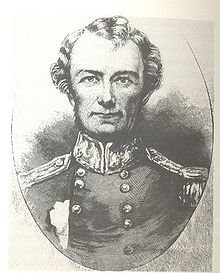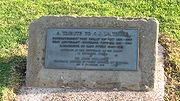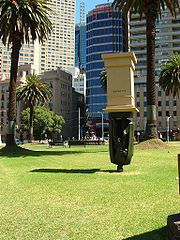- Charles La Trobe
-
Charles La Trobe 
1st Lieutenant-Governor of Victoria In office
15 July 1851 – 5 May 1854Monarch Queen Victoria Succeeded by Sir Charles Hotham Personal details Born Charles Joseph La Trobe
20 March 1801
London, England, UKDied 4 December 1875 (aged 74)
Litlington, East Sussex, England, UKResting place Litlington Church Nationality British Spouse(s) Sophie de Montmollin (1835–1854)
Rose Isabelle de Meuron (1855–1875)Charles Joseph La Trobe (20 March 1801 – 4 December 1875) was the first lieutenant-governor of the colony of Victoria (now a state of Australia).
Contents
Early life
La Trobe was born in London, the son of Christian Ignatius Latrobe, a family of Huguenot origin. He was educated in England and later spent time in Switzerland[1] and was active in mountaineering; he made a number of ascents in the Alps 1824-1826. In 1832 he visited the United States along with Count Albert Pourtales, and in 1834 travelled from New Orleans to Mexico with Washington Irving. La Trobe published several travel books describing his experiences: The Alpenstock (1829), The Pedestrian (1832), The Rambler in North America (1835), and The Rambler in Mexico (1836).[2]
Lieutenant-Governor
In 1837 he was entrusted with a government commission in the West Indies and reported on the future education of the recently emancipated slaves. He then was sent to the Port Phillip District of New South Wales in 1839 as superintendent though he had little managerial and administrative experience. Melbourne had a population of around 3000 at the time and was rapidly expanding. La Trobe commenced works to improve sanitation and streets.[2] As Port Phillip District was a dependency of New South Wales at the time, all land sales, building plans and officer appointments had to be approved by Governor of New South Wales George Gipps, with whom La Trobe had a good personal and working relationship. A Separation Association had been formed in 1840 wanting Port Phillip District to become a separate colony. In 1841 La Trobe wrote to Gipps, asking him to visit Melbourne to form his own opinion on the separation question.[2] La Trobe did not actively campaign for separation, content that Earl Grey had included separation in the reorganisation plan for the colonies.[1] By 1851, when Melbourne had a gold-induced exodus, and the Port Phillip district had gained independence from New South Wales, becoming the colony of Victoria, La Trobe became lieutenant-governor for three years - a position he held until 1854. La Trobe, who had suffered self-doubt and criticisms due to his inexperience had submitted his resignation in December 1852 and had to wait for Charles Hotham to take his place. Towards the end of his governorship, La Trobe's wife Sophie became ill and died after returning to Europe on 30 January 1854.
La Trobe acted as lieutenant-governor of Van Diemen's Land for four months in 1846-47.
Geelong keys
Charles La Trobe is also linked to the discovery of a minor piece of evidence suggesting early European exploration of Australia. In 1847, at Limeburners' Point near Geelong, Victoria, Charles La Trobe, a keen amateur geologist, was examining the shells from a lime kiln when a worker showed him a set of five keys that he claimed to have found, subsequently named the Geelong Keys. La Trobe concluded that the keys were dropped onto the beach around three centuries ago. In 1977, Kenneth McIntyre hypothesized they were dropped by Portuguese sailors under the command of Cristóvão de Mendonça.[3] Since the keys have long been lost their exact origin cannot be verified. However, research by Geologists Edmund Gill and P.F.B. Alsop showed the age of the deposit they were found in dated to 2330–2800 years old, making La Trobe's dating implausible. The error by La Trobe is quite understandable according to Gill and Alsop, given that in 1847 most people thought the world was only 6000 years old.[4]
Legacy
Much of Melbourne's substantial inner city parks and gardens can be attributed to La Trobe's foresight in reserving this land. Melbourne and Victoria are dotted with things named in honour of La Trobe, including La Trobe University, La Trobe Street in the CBD, the federal electorate of La Trobe in Melbourne's outer eastern suburbs, the Latrobe Valley in southeastern Victoria, Mount LaTrobe in Wilsons Promontory, the La Trobe Reading Room at the State Library of Victoria, and Charles La Trobe Secondary College.
See also
- LaTrobe's Cottage
- Latrobe nugget
References
- ^ a b Jill Eastwood (1967). "La Trobe, Charles Joseph (1801 - 1875)". Australian Dictionary of Biography, Volume 2. MUP. pp. 89–93. http://www.adb.online.anu.edu.au/biogs/A020077b.htm. Retrieved 2007-07-13.
- ^ a b c Serle, Percival (1949). "La Trobe, Charles Joseph". Dictionary of Australian Biography. Sydney: Angus and Robertson. http://gutenberg.net.au/dictbiog/0-dict-biogL.html#latrobe1.
- ^ McIntyre, K (1977) The Secret Discovery of Australia, Portuguese ventures 200 years before Cook, p.249-262 Souvenir Press, Menindie ISBN 028562303 6
- ^ Gill, E (1987) "On the McKiggan Theory of the Geelong keys" in The Mahogany ship. Relic or Legend? Proceedings of the Second Australian Symposium on the Mahogany Ship (Ed. Potter, B).p.83-86 Warrnambool Institute Press ISBN 0 949759090
External links
- La Trobe Society
- La Trobe statue at La Trobe University Bundoora
- Governor La Trobe's Instructions, 11 September 1839
- Shaw, A. G. L. (2004). "La Trobe, Charles Joseph (1801–1875)". Oxford Dictionary of National Biography. Oxford University Press. doi:10.1093/ref:odnb/16106. http://www.oxforddnb.com/view/article/16106. Retrieved 22 November 2009. Subscription or UK public library membership required
 "Latrobe, Charles Joseph". Dictionary of National Biography. London: Smith, Elder & Co. 1885–1900.
"Latrobe, Charles Joseph". Dictionary of National Biography. London: Smith, Elder & Co. 1885–1900.- Family tree in Genealogisches Handbuch der baltischen Ritterschaften, Estland, Görlitz 1930 (German)
Government offices New office Lieutenant-Governor of Victoria
1851–1854Succeeded by
Captain Sir Charles HothamCategories:- People from Melbourne
- Governors of Victoria (Australia)
- 1801 births
- 1875 deaths
Wikimedia Foundation. 2010.


